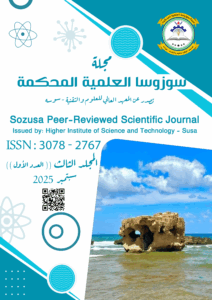Re-isolation, identification, pathogenicity and antibiotic sensitivity during experimental Infection of Nile Tilapia (Oreochromis Niloticus) With Proteus Vulgaris Bacteria under some stress factors
ناجى موسى عبدالرحيم – غيضان خليل سعيد – حنان خليل أمراجع – سالمه أبراهيم أحمدى
الملخص
إعادة عزل و توصيف وأمراضية بكتيريا بروتيس فولقارس المحقونة صناعيا في سمك البلطى النيلي المعرض لظروف بيئية غير ملائمه
Abstract
This study was conducted to isolate, identify, and characterize the pathogenicity of Proteus vulgaris isolated from an experimental infection of Nile tilapia . Sixty Nile tilapia (Oreochromis niloticus) fish with an average weight of 50 g were used. To test pathogenicity, two groups were injected intraperitoneally with the same dose 0.06 ml (1.5 × 109 CFU/ml / fish). Pathogenicity was confirmed in group A of Proteus vulgaris at a water temperature of 27 °C and favorable environmental conditions with a 40% mortality rate, while in group B, pathogenicity was confirmed at a water temperature of 37 °C and adverse environmental conditions with an 80% mortality rate, This indicates the impact of unsuitable environmental conditions on fish health and the rapid spread of bacteria inside the fish’s body, causing deaths.. The injected Proteus vulgaris was re-isolated from the liver, kidney, and intestine of the infected fish.
Keywords: Nile tilapia , Proteus vulgaris , environmental conditions, experimental infection
References
Ahmed, S. M., & Elkamel, A. (2006). Proteus vulgaris, an emerging fish pathogen in Egypt. Assiut Veterinary Medical Journal, 52(111), 36-50.
Austin, B., & Austin, D. (2007). Characteristics of the diseases. Bacterial fish pathogens: diseases of farmed and wild fish, 15-46.
Austin, B., & Austin, D. A. (2016). Bacterial fish pathogens: disease of farmed and wild fish: Springer.
Bilal, S., Anam, S., Mahmood, T., Abdullah, R. M., Nisar, S., Kalsoom, F., . . . Anjum, F. R. (2019). Antimicrobial profiling and molecular characterization of antibiotic resistant genes of Proteus vulgaris isolated from tertiary care hospital, Islamabad, Pakistan. Pakistan journal of pharmaceutical sciences, 32.
Bulbul Ali, A., & Mishra, A. (2022). Effects of dissolved oxygen concentration on freshwater fish: A review. International Journal of Fisheries and Aquatic Studies, 10(4), 113-127.
Daly, J. G., & Aoki, T. (2011). Pasteurellosis and other bacterial diseases. In Fish diseases and disorders. Volume 3: viral, bacterial and fungal infections (pp. 632-668): CABI Wallingford UK.
Dowling, D. C., & Wiley, M. J. (1986). The effects of dissolved oxygen, temperature, and low stream flow on fishes: a literature review. Illinois Natural History Survey Technical Reports.
Elgohary, I., I Abd Elatief, J., G Fadel, N., E Eissa, A., & A Mahmoud, M. (2020). Pathological, bacteriological and seasonal prevalence of Aeromonas hydrophila, vibrio vulnificus, Proteus vulgaris and Pseudomonas aeruginosa; infecting Oreochromis niloticus in some Egyptian fish farms. Egyptian Journal of Aquatic Biology and Fisheries, 24(5), 467-482.
Elkamel, A. A., & Thune, R. L. (2003). Invasion and replication of Photobacterium damselae subsp. piscicida in fish cell lines. Journal of Aquatic Animal Health, 15(2), 167-174.
Elmer, W., Stephen, D., William, M., Paul, C., & Washington, C. (1997). A Color Atlas and Text Book of Diagnostic Microbiology. In: Philadelphia: Lippincott.
Fam, N., Gamal, D., El Said, M., El Defrawy, I., El Dadei, E., El Attar, S., . . . Klena, J. (2013). Prevalence of plasmid-mediated ampC genes in clinical isolates of Enterobacteriaceae from Cairo, Egypt. British Microbiology Research Journal, 3(4), 525-537.
GALAL SAAD EL-DEEN, A. (2013). SUSCEPTIBILITY RATE OF NILE TILAPIA,(OREOCHROMIS NILOTICUS) AND RED SWAMP CRAYFISH,(Procambarus clarkii) to PROTEUS VULGARIS INFECTION. Assiut Veterinary Medical Journal, 59(138), 138-145
Holt, J. S., Powles, S. B., & Holtum, J. A. (1993). Mechanisms and agronomic aspects of herbicide resistance. Annual review of plant physiology and plant molecular biology, 44(1), 203-229..
Ikeogu, F., Nsofor, C., & Ikpeze, O. (2010). A review of risk factors for fish diseases in aquatic environments. Paper presented at the Proceedings of the 6th National Conference of the Society for Occupational Safety and Environmental Health (SOSEH).
Lazm, A. M., Jebur, M. S., & Alomashi, G. B. (2018). Sequencing of HpmA Gene in Proteus mirabilis of UTIs among rheumatoid arthritis patients. Journal of Pharmaceutical Sciences and Research, 10(2), 265-271.
Mandal, S., Mandal, M., Pal, N., Halder, P., & Basu, P. (2002). R-factor in Proteus vulgaris from ulcerative disease of fish, Channa punctatus.
Mehta, K. (2017). Impact of temperature on contaminants toxicity in fish fauna: a review. Indian Journal of Science and Technology, 10(18), 1-6.
Mordi, R., & Momoh, a. I. (2009). Incidence of Proteus species in wound infections and their sensitivity pattern in the University of Benin Teaching Hospital. African Journal of Biotechnology, 8(5).
MUROGA, K. (1979). Ulcer disease of akame (Mugilidae) in the estuary of the River Ashida. Fish Pathology, 13(3), 163-167.
Okaeme, A. (1989). Bacteria associated with mortality in tilapias, Heterobranchus bidorsalis, and Clarias lazera in indoor hatcheries and outdoor ponds.
Quinn, P., Markey, B., Carter, M., Donnelly, W., & Leonard, F. (2002). Bacterial colonization, tissue invasion and clinical disease. Veterinary microbiology and microbial disease, 1st ed. PJ Quinn, BK Markey, ME Carter, WJ Donnelly, and FC Leonard, eds. Blackwell Science, Oxford, England, 36-40.
Ramaiah, N. and Manohar, L., (1988). Indian Fisheries Forum, Mangalore (India). Joseph, M. Editor. ISBN 8183340005
Holt, J.G.; Krieg, N.R.; Sueath, P.H.A.; Satley, J.T. and Williams, S.T. (1993). Bergey’s manual of determinative bacteriology. 9th ed. Baltimore: Williams and Wilkins
CLSI, (2010). Performance Standards for Antimicrobial Susceptibility Testing, 20th Informational Supplement. Clinical and Laboratory Standards Institute, M100-S20 & M100-S-20-U

